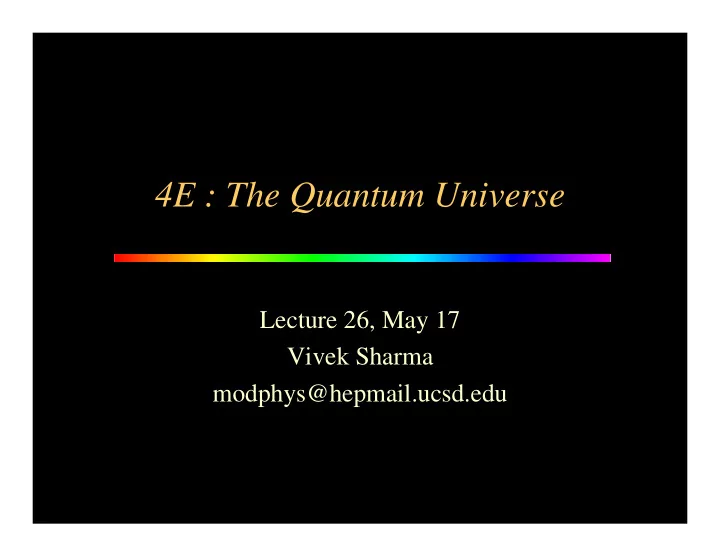

4E : The Quantum Universe Lecture 26, May 17 Vivek Sharma modphys@hepmail.ucsd.edu
Radial Probability Distribution P(r)= r 2 R(r) Because P(r)=r 2 R(r); No matter what R(r) is for some n, The prob. Of finding electron inside the nucleus = 0 !! 2
Normalized Spherical Harmonics & Structure in H Atom 3
Excited States (n>1) of Hydrogen Atom : Birth of Chemistry ! θ φ Features of Wavefunction in & : = = ⇒ ψ = Consider 2, 0 Spherically Symmetric (last slide) n l 200 Excited States (3 & each with same E ) : n ψ ψ ψ , , are all 2 p states 211 210 21- 1 − 3/ 2 ⎛ ⎞ ⎛ ⎞ Zr ⎛ ⎞ ⎜ ⎛ ⎞ 1 Z Z r φ ψ θ 1 a . i ⎟ ⎜ ⎟ =R Y = ⎜ ⎟ a ⎜ ⎟ . sin e e 0 211 21 1 π ⎝ ⎠ ⎝ ⎝ ⎠ 8 ⎠ ⎝ a ⎠ 0 0 π ψ = ψ ψ ∝ θ θ θ φ 2 * 2 | | | | sin Max at = ,min at =0; Symm in 211 211 2 21 1 = � W hat about (n=2, =1, m 0 ) l ψ = θ φ 0 2p z (r) Y ( , ); R 210 21 1 1 3 θ φ ∝ θ 0 Y ( , ) cos ; π 1 2 π θ θ Function is max at =0, min a t = 2 We call this 2p state because of its extent in z z 4
Excited States (n>1) of Hydrogen Atom : Birth of Chemistry ! Remember Principle of Linear Superposition for the TISE which is basically a simple differential equat ion: � 2 ∇ ψ + ψ = ψ 2 - 2m U E ⇒ ψ ψ Principle of Linear Superposition If are sol. of TISE a nd 1 2 then a "des igne r" wavefunction made of linear sum ψ = ψ + ψ ' i s also a sol. of the diff. equ ation ! a b 1 2 ψ ψ ' To check this, just substitute in pla ce of & convince yourself that � 2 ∇ ψ + ψ = ψ 2 ' ' ' - U E 2m The diversity in Chemistry and Biology DEPENDS on this superposition rule 5
Designer Wave Functions: Solutions of S. Eq ! Linear Superposition Principle means allows me to "cook up" wavefunctions 1 [ ] ψ = ψ + ψ ......has electron "cloud" oriented along x axis − 2p 211 21 1 x 2 1 [ ] ψ = ψ − ψ ......has electron "cloud" oriented along y axis − 2p 211 21 1 y 2 ψ ψ ψ ψ − → So from 4 solutio ns , , , 2 ,2 ,2 ,2 s p p p 200 210 211 21 1 x y z Similarly for n=3 states ...and so on ...can get very complicated structure θ φ in & .......whic h I can then mix & match to make electron s " most likely" to be where I want them to be ! 6
Designer Wave Functions: Solutions of S. Eq ! 7
Cross Sectional View of Hydrogen Atom prob. densities in r, θ , φ Birth of Chemistry (Can make Fancy Bonds � Overlapping electron “clouds”) What’s the electron “cloud” : Its the Probability Density in r, θ , φ space space ! Z Y 8
More Radial Probabilities P(r) Vs. r/a 0 Net Prob. densities for n=2 states Doughnut spherically dumbbell (toroid) symmetric 9
Radiative Transitions: An Impromptu Discussion • Concepts – Write and use the wavefunctions which arise as solutions of the time-dependent Schrodinger equation – Use concept of linear superposition of time-dependent wavefunctions – Calculate expectation value for <x>, when is it time-dependent? • See slides (posted) from Lecture 27 ( See also Modern Physics by Beiser, chapter 6, sections 8-9, page 214. Text available from the E-reserve page as pdf files 10
Recommend
More recommend